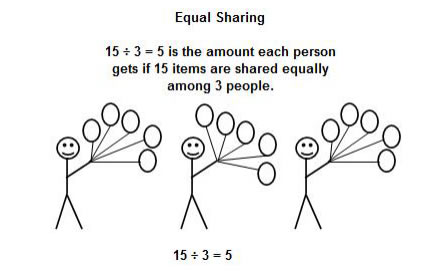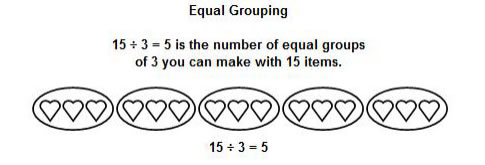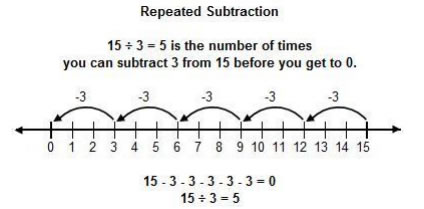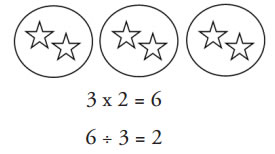Division - Grade 3
Related Topics:
Understanding Multiplication
Videos, solutions, worksheets, games and activities to help Grade 3 students understand division.
This lesson will help you develop an understanding of division by:
• representing and explaining division using equal sharing
• representing and explaining division using equal grouping
• relating division to repeated subtraction
• relating division to multiplication.
When one number is divided by another, the number being divided is the dividend. The other number is the divisor. The result is the quotient.
It is important to understand the three meanings of division:
- Division as Equal Sharing
- Division as Equal Grouping
- Division as Repeated Subtraction
Division as Equal Sharing
In the sharing situation, some known quantity (amount) is shared equally among a known number of entities (people, boxes, packages, etc.). What is not known in a sharing situation is the amount of the given quantity per share. The quotient in this situation represents the amount per share, the size of each share or the unit rate.

Show division as equal sharing
Example:
Use division to share 6 jelly beans between two friends.
Division by Sharing
Example:
12 ÷ 3
Division as Equal Grouping
In a grouping situation, the unknown is the number of groups of a given size that can be made from a given quantity (amount). The quotient in this situation tells how many groups of the specified size can be made from the given quantity

Division by grouping using objects
Example:
12 ÷ 4
Division by Grouping
Examples:
- Six angry bird characters want to have a game of soccer.
a) Put them into groups of three. How many teams are made?
b) Put them into groups of two. How many teams are made?
10 ÷ 2
18 ÷ 6
20 ÷ 4
15 ÷ 3
Division as Repeated Subtraction
To divide using repeated subtraction, subtract equal groups from the total until you reach 0. Division is a shortcut for repeated subtraction.

Division = Repeated Subtraction
This video shows you that division is repeated subtraction and that you can use subtraction to get answers to division problems.
How to divide by using repeated subtraction on an empty number line?
Step 1. Write the calculation clearly.
Step 2. Draw an empty number line.
Step 3. Start from the right hand side of the number line.
Step 4. Subtract by groups.
Step 5. Count the jumps
Example:
12 ÷ 3 =
Division is repeated subtraction
Example:
21 ÷ 3
Relate Multiplication and Division
Multiplication and division “undo” each other. They are inverse operations.
For example, if
3 × 2 = 6 then 6 ÷ 3 = 2.

Relating Multiplication and Division
Objectives
• Use division to find a missing factor.
• See the relationship between multiplication and division.
• Use a letter to represent an unknown.
• Review basic multiplication facts that have 0,1,2, or 5 as one of the factors.
• Identify and memorize the memory group of multiplication facts.
If we know the two factors, we multiply to find the product. If the factors are 4 and 3, the product is 12
If we know one factor and the product, we can find the other factor. 4 &time; w = 12, w × 3 = 12.
We can use division to find the missing factor.
Multiplication and division are inverse operations. One operation undoes the other. It is like a fact family.
Examples
Find the missing factors
a) 5n = 40
b) a × 4 = 36
How are Multiplication and Division related?
Examples:
- How would you use counters to make an array to show 2 × 6?
How many different multiplication and division sentences can you write to represent the array?
- Each trading card sheet has 3 rows with 2 pockets in each row. How many pockets are on each sheet?
- Complete each family fact.
Try out our new and fun Fraction Concoction Game.
Add and subtract fractions to make exciting fraction concoctions following a recipe. There are four levels of difficulty: Easy, medium, hard and insane. Practice the basics of fraction addition and subtraction or challenge yourself with the insane level.

We welcome your feedback, comments and questions about this site or page. Please submit your feedback or enquiries via our Feedback page.